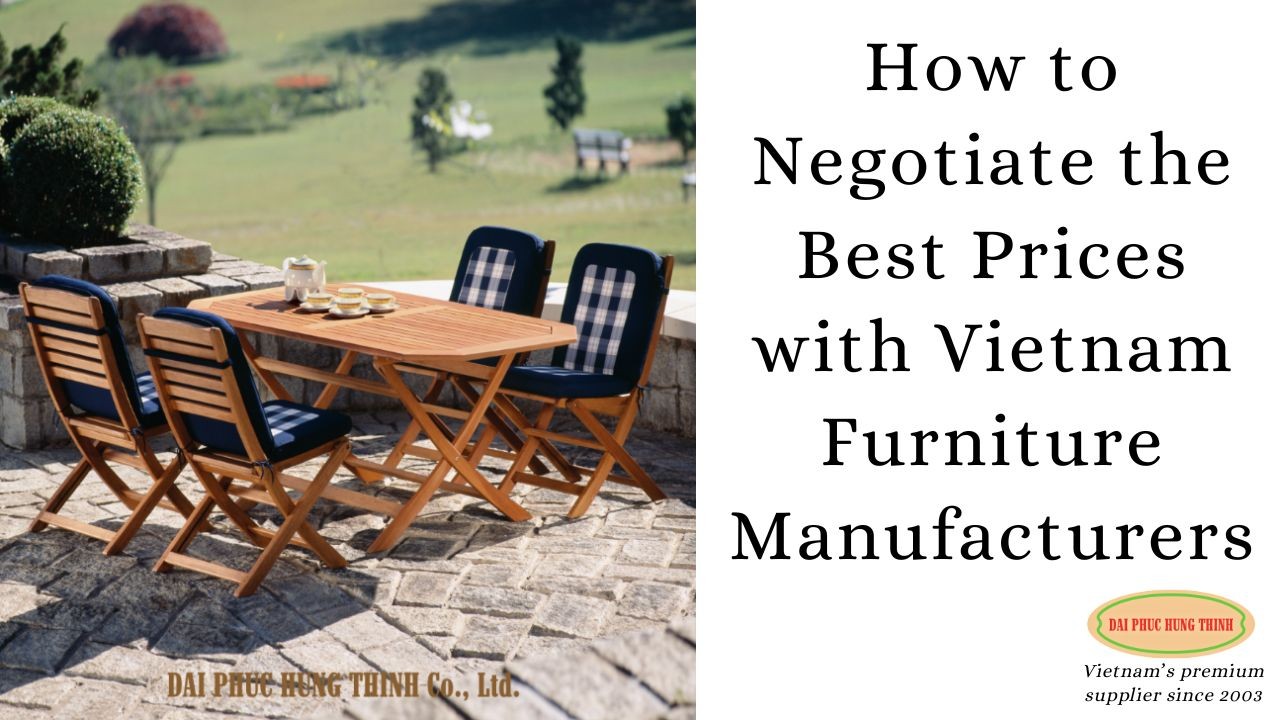With rising tariffs and increasing supply chain uncertainties in other countries, Vietnam has become a top destination for high-quality, competitively priced furniture. However, securing the best price from Vietnamese furniture manufacturers requires more than just comparing quotes—it demands a strategic approach, industry knowledge, and strong negotiation skills.
This guide provides key negotiation tactics to help importers, wholesalers, and retailers maximize their purchasing power while maintaining product quality and long-term supplier relationships when sourcing furniture made in Vietnam.
1/ How To Do Your Research Before Negotiating
Before reaching out to a supplier, know the market price of the furniture you are looking to purchase. Use online B2B platforms like Alibaba and Global Sources to compare pricing. Additionally, consider attending furniture trade shows such as VIFA Expo (March 5-8, 2025) and HawaExpo (March 6-9, 2025) to get firsthand insights.
A great strategy is to pick a popular product like a folding chair or table and send quote requests to multiple Vietnamese furniture manufacturers. This allows buyers to compare pricing, assess supplier responsiveness, and narrow down potential suppliers before deciding who to meet in Vietnam.
Understanding raw material costs is also crucial. Acacia, eucalyptus, and teak furniture all have different pricing structures, so knowing the cost breakdown can help in negotiations. Additionally, larger manufacturers often provide better pricing for bulk orders, while smaller Vietnamese furniture factories may offer more flexibility on minimum order quantities (MOQs).
2/ How To Build Relationships Before Discussing Price
In Vietnamese business culture, relationships matter. Unlike Western markets where price is often the starting point, in Vietnam, a strong working relationship with a supplier can lead to better pricing in the long run.
Instead of committing to a large order right away, importers should consider starting with 1-3 different products in a 20 HC container, and up to 5 products in a 40 HC container. This strategy helps test supplier reliability and product quality before making a bigger investment.
Additionally, ask for certifications such as FSC (Forest Stewardship Council) and ISO compliance to ensure suppliers meet international standards. A factory visit—or hiring a third-party inspection service—can further verify credibility and quality standards before proceeding with a long-term agreement.
3/ Negotiate Beyond Price – Look at Total Value
Focusing on price alone can be a mistake—buyers should consider the total value of their order.
For shipping, negotiating FOB (Free on Board) pricing allows buyers to control freight costs and choose their own logistics providers. Payment terms also play a role in cash flow management, and while the standard is 30% deposit, 70% before shipment, buyers can negotiate 20/80 terms for better flexibility.
Bulk discounts can be leveraged for cost savings, as larger orders often result in lower unit prices. If demand is consistent, securing long-term supplier agreements can lead to better pricing. Additionally, customization options such as free samples, improved packaging, or enhanced finishing can be negotiated to add extra value to an order.
4/ How To Be Strategic, and Culturally-Mindful, During Price Negotiations
When discussing pricing, be professional, firm, and reasonable. Having multiple supplier quotes strengthens your bargaining position, allowing you to compare offers and negotiate effectively. If a supplier quotes a high price, a moment of silence can sometimes encourage them to reconsider. Additionally, referencing competitor pricing can be a useful tool—if you have a better offer elsewhere, mentioning it may lead the supplier to offer a discount or better terms.
Western buyers should also be mindful of the concept of “losing face” in Asian business culture. Pushing too aggressively or openly criticizing an offer can create tension and make negotiations more difficult. Instead, approach discussions with mutual respect, patience, and constructive feedback to build long-term rapport and secure a better deal.
Finally, be prepared to walk away if necessary. If the pricing is too high, politely declining the offer can sometimes lead to a counteroffer with more favorable terms.
5. Finalize the Deal with a Written Agreement
To avoid miscommunication, every aspect of the deal should be documented in writing.
Payment terms and lead times should be clearly outlined, specifying the deposit amount, balance payment conditions, and expected production timeline. Quality standards must also be defined, including material specifications, finishing details, and any agreed-upon tolerances. Additionally, it is essential to confirm shipping arrangements, particularly Incoterms such as FOB or CIF, and ensure that both parties agree on the delivery schedule.
For buyers sourcing outdoor furniture wholesale, specifying durability and weather-resistant standards, as well as manufacturer insurance and defects, in the contract is essential when working with outdoor furniture manufacturers in Vietnam.
Next Step
Negotiating with Vietnam furniture manufacturers requires preparation, relationship-building, and strategic pricing discussions. By focusing on total value instead of just price, importers can secure better deals and long-term partnerships.
At Dai Phuc Hung Thinh Furniture, we have been in the industry since 2003, supplying high-quality FSC-certified furniture to some of the largest retailers, including Segmuller and JYSK. As one of the most experienced Vietnamese furniture manufacturers and a family business, we specialize in furniture made in Vietnam, including outdoor furniture wholesale solutions tailored for global buyers.
Whether you’re looking to partner with a Vietnamese furniture factory for your next order or need expert guidance on securing the best pricing, we are here to help. Contact us today at sales@daiphuchungthinh.com.vn to get started!


